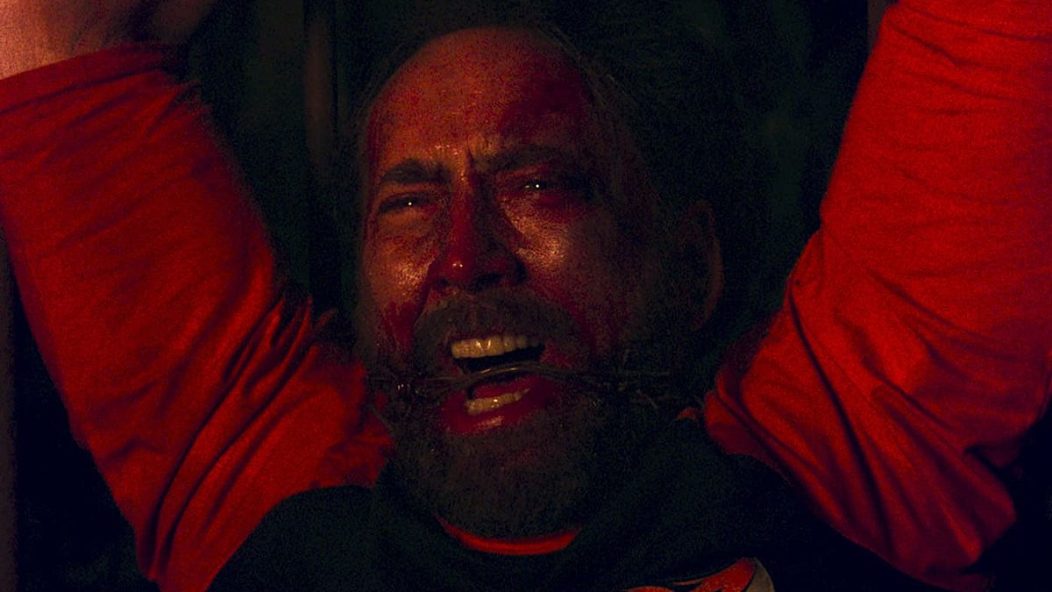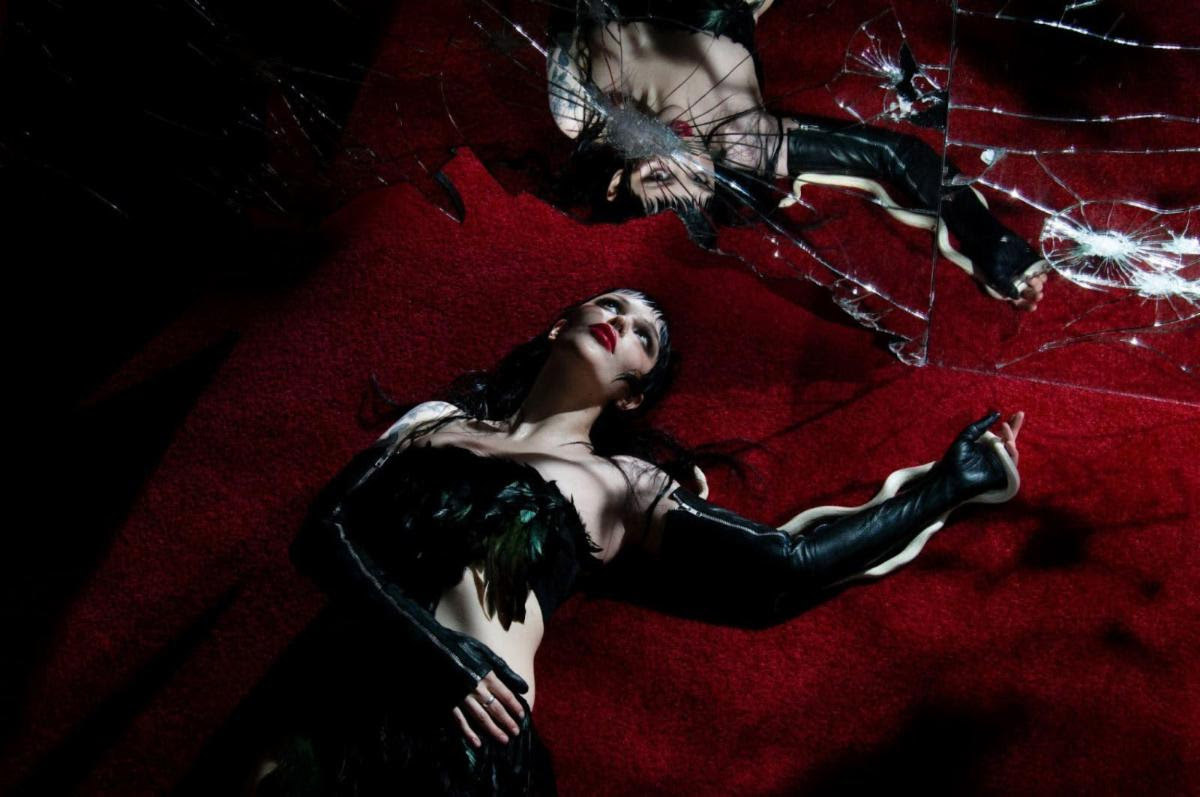
The Metal of "Mandy"

…
There seems to be a general Internet consensus regarding the “metal-as-fuckness” of Panos Cosmatos’s new film Mandy. The movie, which stars a gonzo-as-ever Nicolas Cage, certainly has its fair share of cvlt signposts. A mere plot summary reads like a discarded idea for a Mastodon concept album: Cage plays Red, a Motley Crue t-shirt-clad lumberjack who, following the murder of his titular lover by immolation at the hands of an acid cult, slays demons with an axe that he forges himself. Then, he engages in a chainsaw fight and kills the leader of the cult in a burning church. King Crimson and a doom-inflected Johann Johannsson score (one of his last before death and featuring performance by Sunn O)))’s Stephen F O’Malley) share space on the soundtrack.
All of that is fun and good, and probably reason enough to get a lot of metalheads into the theater (it’s certainly what got me there). All you have to do is read a few sentences about the film to know whether or not it’s going to be your bag,
…
…
While I enjoyed those elements of the movie on their own terms, I was surprised to find that there’s a lot more going on here, formally, then I would have expected from such a summary. And while some of those formal qualities aren’t quite as obviously Heavy Metal, I’ve come to the conclusion that metal serves a deeper guiding aesthetic roadmap for the film, going well beyond those more obvious design elements. The film just feels metal in a deeper way than I was ready for, and that association gives the film much of its power, its distinct, lumbering heaviness that lands punch after punch and left me, as a viewer, feeling exhausted but elevated.
The film is split into two distinct sections. There’s a slower, dreamlike initial passage that anchors us in the rural domestic bliss of Red and Mandy and the internal dynamics of the murderous cult, which eventually gives way to the much rowdier revenge antics of the second act. I came into the film expecting the cheap thrills that the second half delivers, but the first section is so convincing and engrossing that I ended up surprised when the blood started to fly.
This is, obviously, no accident. Cosmatos gives the revenge story a surprisingly emotional undercurrent by committing fully to environment in the first half, and he does this by almost purely aesthetic means. Dialogue is extremely limited — there’s so little exposition in this thing, that when we finally do get an explanation for some of the stranger goings-on in the plot, Cosmatos basically turns the detailedness of that explanation into a joke.
The script’s sparseness in these early scenes allows the audience to luxuriate in the sound in images, to feel without the burden of detail. And much of that aesthetic environment feels metal — the pacing, the color palette, and the actual setting all conjured some of the specific wonder that I feel when immersed in a good metal record.
The first half of the movie is, I think, key to understanding why Cosmatos’s metal aesthetic works the way it does. The early parts of the film are deliberate to the point of slowness (in the New York Times review of the film, critic Glenn Kenny called it “pulp Tarkovsky,” which isn’t bad). Cosmatos seeks the effects of that particular pace and tone when juxtaposed with gonzo immediacy. On a macro level, it’s structured like a doom metal song. The languid, distended structuring of time is an end in itself. It alters your perception, allows your focus to toggle in and out, priming you for moments when something can finally and triumphantly cut through the murk.
The first half underlines the camp of the second, heightens its impact in contrast to what preceded it. I find myself listening to a lot of records, and watching a lot of films, that impress but ultimately exhaust with a single-minded aesthetic focus, and the brilliance of Mandy lies in its ability to shift gears, and in the seamless fitting together of seemingly incongruous tonal elements.
Cosmatos uses a number of visual effects that induce surreality, giving the film an aesthetic otherworldliness that conjures heavy metal’s mythic sonic landscapes. He’s got a JJ Abrams-level of affection for lens flares, the uses of which make the real-world setting of the film feel alien and subconscious. Cosmatos mines the forested setting for every ounce of mystical terror it can conjure. When Mandy (played remarkably by Andrea Riseborough) is given LSD against her will, the director manages to visualize the trip in a cliche-free, genuinely unsettling manner. Cosmatos has said that he wants the film to have a “rock opera feel,” and there’s a musicality with which he wields control over tone.
Out of this primordial soup of devil-horns signifiers, style, and atmosphere emerges a film of remarkably assured form and shape. The strongest moment in the film is a jaw-dropping single-take scene where Red, fresh from witnessing his partner’s death and escaping the bad guys, stands in the bathroom in his underwear and Crue shirt, with a bottle of vodka, aggressively drinking from it, screaming, and pouring it on his wounds. It brings all of Cage’s mania to bear in a way that’s shattering, and serves as a pivot point between the quiet beauty and menace of the first half and the b-movie carnage of the second. It clarifies the film’s high-low approach, and grounds the ensuing carnage in deeply felt rage and sorrow.
The film is aware of Cage’s not-always-serious cultural connotations, and it uses them to communicate often contradictory aims — the artificiality of his performance conjures genuine emotion, brings the film to a register where camp and solemnity can harmonize. This relationship, to me, is a quintessentially metal one — rage and violence as a product of real despair. Metal is in many ways an aesthetic embodiment of that concept in the ways it seeks to justify and give expression to the uglier sides of living, often by pairing them with nastier kinds of fun. For the first time that I can recall, Mandy made me wonder whether there might be a genuine natural affinity between heavy metal and the history of high-minded slowcore European art-cinema that this film draws from (the aforementioned Tarkovsky and modern descendents like Bela Tarr and Roy Andersson) in that each mines discomfort in pursuit of transcendence.
I think ultimately that’s where I find the metalness of Mandy most pronounced and most resonant. It’s more overt metal references are echoed in the overarching formal qualities in the film, which relies on the coexistence of conflicting modes of expression. The best heavy music, or my favorite at least, wants to have it both ways. It wants to be scary and ugly and beautiful, brainy and dumb, funny and sad, complex and simple, all at the same time. It posits a world where we, as listeners, don’t have to choose between those things, and get to experience them more fully when they’re juxtaposed against each other, when they operate on the same plane.
Mandy, a movie in which Nicolas Cage snaps a demon’s neck before triumphantly doing coke off a knife, similarly denies the separation between cheap thrills and expensive contemplation. It’s a metalhead’s movie through and through, which is to say it plays in a specific register but it isn’t interested in formal limitations. Which is also to say, it pretty much rips.
…











